Month 1: Space Ace
‘In-betweeny’ slots into a sweet spot
Price as tested: $41,490
Fuel this month: 497km @ 9.7L/100km
Short and relatively sweet is the best way to describe my experience with the latest addition to the Wheels long-term garage.
Joining the fleet this month is a Mazda CX-30. A G25 Astina FWD, to be precise. We have become well acquainted with the Mazda 3 hatch on which it’s largely based, having run one as a long-termer late last year, and now it’s time to see if this highly anticipated model can replicate the experience enjoyed by Trent.
The CX-30 should retain the values that earned the Mazda 3 a top-three place at Wheels Car of the Year 2020, but there are some key differences with this model, namely the G20 specification that brings with it the smaller-capacity engine.
I am but a temporary custodian, though, because Andy Enright takes the keys from next month.

Built as the Goldilocks proposition to sit between the popular CX-3 and CX-5 models, the CX-30 fits neatly in that niche in every dimension. This has benefits, with the nimble hatch-like ability and manoeuvrability of the CX-3 retained, while adding vital millimetres to the interior space and litres to the boot.
But don’t be lulled into believing that this makes the CX-30 a load-lugger – it is based on the Mazda 3 hatch, after all. No, this remains a style-driven vehicle that forgoes some utilitarian practicality for dashing good looks.
Mazda’s ‘fluid’ design language is on full display with the CX-30, and I think it works well. The little Mazda stands out even when rubbing shoulders with more expensive European offerings in the leafy inner-city suburbs of Melbourne.
The cabin is beautifully presented – and to think this isn’t even the top spec – with every touch point a testimony to well thought-out design and placement.
At a time when car makers across the pricing spectrum are moving to bigger touchscreens inside their cabins, Mazda has made the interesting choice to move the screen further away from the driver, effectively out of finger-prodding range. To me, that’s a good thing because, while the screen (non-touch in this case) is further away, it is closer to your eyeline when driving.
I find a touchscreen system more distracting to use than Mazda’s rotary-dial set-up. It avoids a bugbear of mine, which is having to use a touchscreen for a function that should be a button – particularly climate control.

Not all of Mazda’s technological advancements had me smiling, though. While a full suite of safety functions comes as standard on the CX-30, their functionality isn’t as refined as you’ll find in its competitors.
The blindspot monitoring caught my ire in particular, being triggered by a particularly high kerb, as well as parked cars. These false positives are annoying both in their intrusive tone and in the way they erode confidence in such an important safety system.
But kudos to the active cruise control, which is calibrated in such a way that it feels natural in how it builds and removes speed on a relatively quiet freeway.
The CX-30 kicked off its stay with us by returning 9.7L/100km from a single tank. It’s not bad, but certainly not great. The atmo four-pot requires a deft right foot off the line to prevent the revs from flaring if you want to get away from a standstill with a minor sense of urgency.
Will the CX-30 enjoy a rosy sheen at the end of its tenure in our long-term stable? I’ll defer to Enright to decide that in a couple of months.
– CAMERON KIRBY
Month 2: Eye of the Beholder
A new custodian brings a fresh perspective
This month: 1571km @ 8.4L/100km
I’ve come to realise that running a long-termer like this Mazda CX-30 has both plus and minus sides to the ledger. While it’s great to really get to know a vehicle in the way that you never can with just a day or two spent on a road test, it’s inevitable that manufacturers engineer their cars to make the good stuff overt and the less-brilliant aspects a bit trickier to unearth.
When Cam Kirby handed the CX-30 over to me, he wasn’t particularly impressed with the fuel figures he’d seen. That was surprising, as Mazda has long campaigned on the fact that a decently sized atmo engine will tend to return better fuel figures in the real world than a downsized turbo engine that’s often been designed to game laboratory fuel-economy tests. Therefore, the 9.7L/100km he saw in our G25 Astina seemed to run counter to that theory. Kirby does a lot of city driving, where my use is a little more open road, and that has helped economy improve to 8.4L/100km during my tenure.
As a Wheels comparison test winner, the CX-30 G25 Astina is undoubtedly a class act. The interior finish is extremely good, it handles sweetly and the instruments are a model of clarity. With such attention to detail, it’s odd that a couple of detail-oriented errors have crept in. A mis-spelled error message flashed onto the screen warning me of ‘Low Camera Visibilty’ at one point.
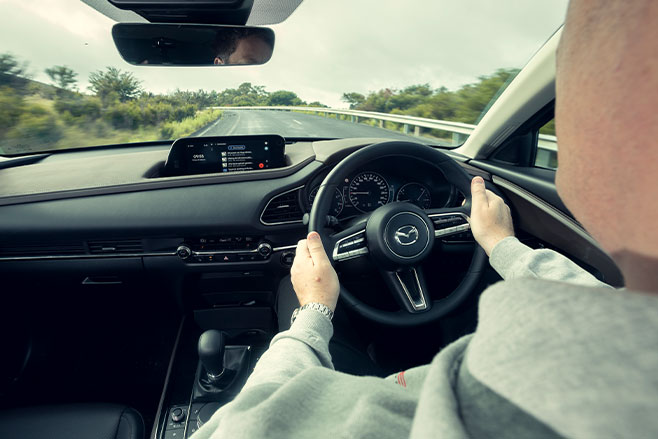
I’m an Android Auto user, and the smartphone mirroring works well on the whole, but once in a while the system will have a bit of a tug of war over whether a podcast gets to be played via the wired Android Auto connection or the Bluetooth connection to your phone. This manifests in the audio cutting out, switching automatically to the other source and the podcast stopping. That can become annoying when you’re settling into a freeway trip.
These are but minor blips that I’ll doubtless find a way to work around. Slightly more trying is the poor calibration of the adaptive cruise control on busy major routes. It brakes jerkily and then drops a gear and guns the engine to accelerate back up to speed when the lane ahead clears. I’ve learned to leave it well alone on anything but sparsely trafficked roads.
Overall, I have warmed to the CX-30. There’s an easy practicality and sweet nature to it that’s been slightly marred by a few weird calibration oversights. Everything is a relatively easy fix in terms of vehicle development, but if you’re a current owner, they might just take the shine off the experience. Viewed objectively, however, the CX-30’s positive attributes weigh massively in its favour. I’ll take that.
– ANDY ENRIGHT
Month 3: Splendid isolation
Amid ‘the big pause’, the CX-30’s character shines
This month: 545km @ 7.4L/100km
I have taken to keeping a copy of Wheels in the seatback pocket of the Mazda CX-30. That and an email from Victoria Police ought to prove to any testy roadside rozzer that this is a test car that requires driving, something I clearly can’t reasonably do at my desk at home.
That said, a couple of other engagements have meant that my use has been strictly local, the CX-30 doing a sterling job of bumping up dirt tracks in the hills to spots where my partner and I can go for a walk in complete isolation. As a result, the body surfacing that Mazda is so proud of is frequently plastered with mud. Inwood claimed to need the CX-30 recently for a TV shoot, so I took it to a jetwash and removed the most egregious spatters only to find that the plastic body mouldings, which look pristine when wet, later dry to a muddy brown. A bit of elbow grease is required for these to come up clean.
As time passes, I’m appreciating some of the CX-30’s genuinely thoughtful touches. I love the subtle red line on the analogue speedo that indicates where the speed limit is. The deep central storage box can keep all manner of gear out of sight when you leave the car for a few minutes, while the keyless go is a boon if, like me, you’re particularly pernickety about hand cleansing and cross-contamination.
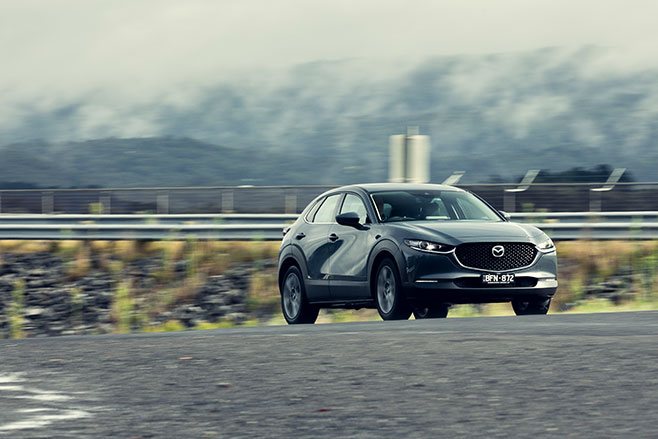
One thing is irking me and it’s the standard sat-nav. It’s directed me up roads that don’t exist, and I haven’t discovered a way for it to auto-dim the glaring white screen when the sun dips behind the horizon. Thankfully, there’s always Android Auto to the rescue. I’ve just treated myself to a new subscription to the Tidal music streaming service to keep me sane at home, and flicking through tracks on Android Auto’s interface is simple using the wheel-mounted controls.
The front-drive CX-30’s fuel economy, which looked worryingly high when Cam Kirby handed the vehicle over to me, has now settled nearer to what I’d originally expected from it – a more modest 7.4 litres per 100km. Good, but not great in the overall scheme of things, and still a little way off Mazda’s 6.6L/100km ADR figure.
Would I recommend the CX-30 to a friend? Certainly. It’s a very good thing, and the longer I spend with it, the more I’m keying into its low-maintenance, easygoing personality.
It just takes a bit of knowing.
Tanks a lot
I haven’t figured out why the CX-30 needs two fuel gauges, displayed in such close proximity. There’s both a digital meter with a range figure and an analogue-style needle gauge. Both agree with each other and both go down too quickly, due to the CX-30’s dinky 48-litre fuel tank.
– AE
Month 4: Lock down the details
Enright discusses the finer points of CX-30 ownership
This month: 1317km @ 6.3L/100km
I’ll freely admit that I was surprised that BFN872 has covered over 1300km for this report. It seems that even when used infrequently, essential journeys for a motoring scribe can tot up. So I thought I’d try to cover some of the CX-30’s finer details that you’d only discover with an extended spell with the car. So here – drum roll, please – are the Five Mazda CX-30 Facts You Won’t Find in the Road Test.
1) If your new Mazda isn’t getting the fuel economy you expected, just wait a while and it’ll get better. Throughout its tenure in the Wheels garage, the CX-30’s fuel figures have steadily improved, from 9.7L/100km to begin with to a figure of just 6.3L/100km this month. That’s 0.2L better than the ADR figure now that 6000-odd kilometres have loosened up the 2.5-litre engine a little. Bravo.
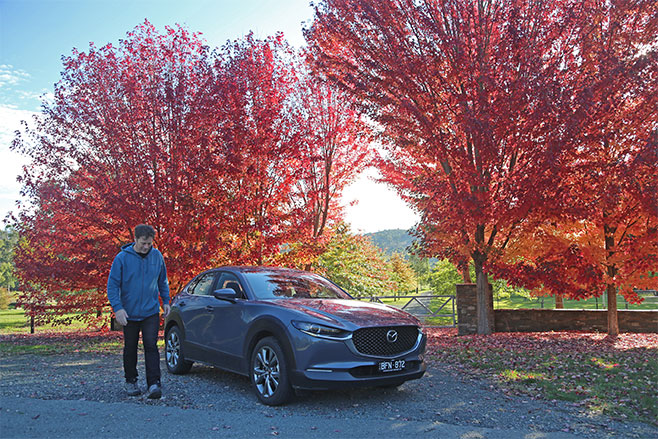
2) We’ve mentioned the thoughtful touches in the cabin in the past, but the illuminated starter button is a peach. Get into the car at night, rest your foot onto the brake pedal and the starter ring will light up in white and pulse a green centre LED.
3) Rather than use the rotary controller to tediously hunt and peck between, say, Android Auto maps and the Tidal music service on the non-touch screen, the physical navigation and audio buttons on the centre console will do the job instantly. That’s in contrast to Honda, for example, which will default you back to its proprietary nav system, forgetting that you were using phone mirroring for your direction finding.
4) Aside from the starter button, the CX-30 doesn’t do night particularly well. The nav screen is blinding white and the cabin also features a very bright airbag warning light almost at eye height near the rear-view mirror. Then there’s the automatic high beam function for the headlights that gets flummoxed far too easily and can dazzle oncoming drivers.
5) Stay on top of your tyre pressures. I’d been happily checking the tyres to placarded pressures during summer and they were fine. As the weather has become colder, I’ve noticed the CX-30’s front Dunlops (never a great tyre at the best of times) feel sloppier. Given that you lose 1psi per 5.6°C drop in temperatures (and it’s been pretty chilly in my locale), upping the pressures by 2-3psi has rectified the problem. Thankfully, the Mazda is back to its perkiest.
Although I seem to be have done a rather shambolic job of staying home during lockdown, hopefully it helps you better understand the intriguing CX-30. As the date approaches when it returns to its manufacturer, I’m beginning to think that whatever replaces it will have some quietly competent boots to fill.
Blue-sky thinking
Mazda’s revolutionary Skyactiv-X engine will join the CX-30 range in a matter of months.
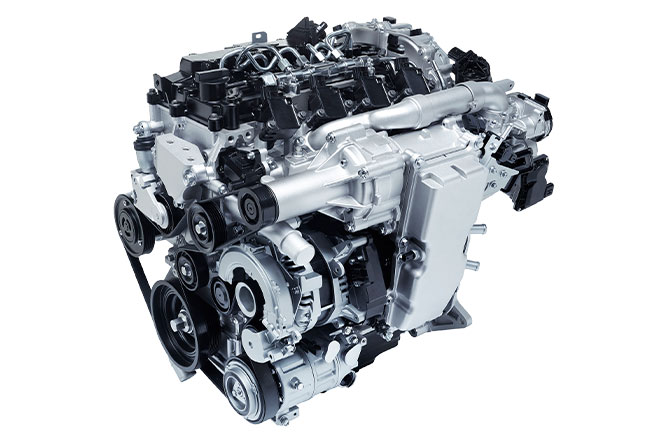
Mazda claims an efficiency boost of between 20 -30 percent for the 132kW/224Nm 2.0-litre unit, which features a supercharger and mild-hybrid tech. It’s being positioned as a flagship powertrain, so it won’t be cheap. We’d expect the top Astina model to retail north of $45K.
– AE
Month 5: Fade to grey
Enright says sayonara to the super-subtle CX-30
This month: 1846km @ 6.9L/100km
Overall: 5279km @ 8.0L/100km
Nobody commented much on the Mazda CX-30 while it was in my tenure. Despite being one of the first on the road in Oz, not a single person asked what it was. It’s pretty much the invisible car, a small SUV in a vast ocean of rival offerings, not helped here by its dour grey paint finish.
Where Kirby was mobbed by groupies wanting to borrow his Jimny and Inwood was desperately cobbling up excuses not to let the keys to his Fiesta ST leave his person, I knew that the Mazda would always have my seat, mirrors, and phone settings in place.
Despite its anonymity, I found myself growing to enjoy its quietly handsome styling. I’d find myself catching a glimpse of the CX-30 on the CCTV camera monitors at home and being struck by the coupe-like swoop of the glasshouse. Likewise, the cabin’s considered finish, quality touch points and unfussy practicality were features that grew in importance over time.
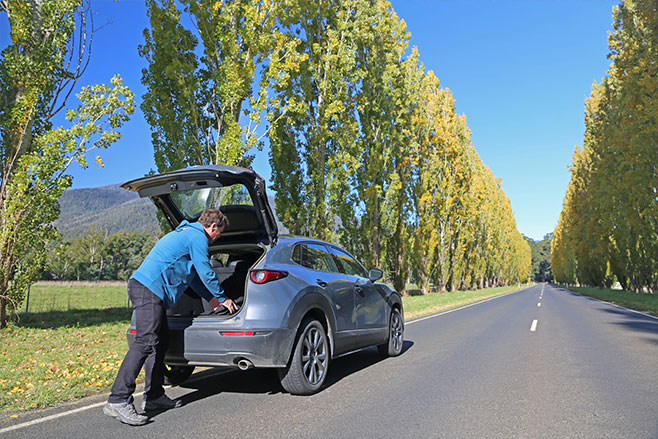
Strangely, for a Mazda at least, it was the way the CX-30 went down the road that left me largely cold. While the ride quality was good and the steering accurate, the tyres on the CX-30 and the vehicle’s comatose body control never really got me juiced to drive it. Couple that with a flat-sounding 139kW and it’s not a recipe for much in the way of excitement.
Dial things back, accept that the CX-30 isn’t going to be much of a corner carver and it’s all perfectly pleasant. And for many people in this price bracket, perfectly pleasant is more than an acceptable measure of success. It does have its quirks, though. The keyless unlocking seemed to have a mind of its own, usually managing to figure out when the key was in your most inaccessible pocket and then refusing to unlock the door when giving the handle a tug.
MORE All the local pricing and specs for the CX-30 range
Despite some minor peccadilloes, the CX-30 was a very easy car with which to live, with excellent reliability, decent comfort levels and steadily improving fuel economy. In recent months it was routinely dipping into the sixes, which isn’t far off its ADR of 6.6L/100km for this front-driver.
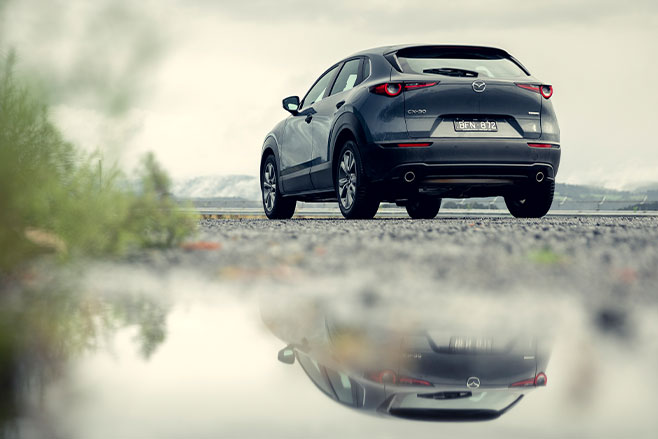
On test against the Kia Seltos and Toyota C-HR, the CX-30 proved the lightest, quickest, best finished and most comfortable. Its 317-litre boot may be an impediment to family buyers, though. Better for quality-conscious empty-nesters. People of my demographic, in short.
We tend to think of pleasantness as a measure of damning with faint praise when assessing cars. It’s usually a fallback option in lieu of overt talent. Yet sometimes making a car quietly endearing and fuss-free creates the basis of a very solid long-term relationship. The CX-30 is a slow burn yet, over time, you’d never regret your purchasing decision.
– AE





